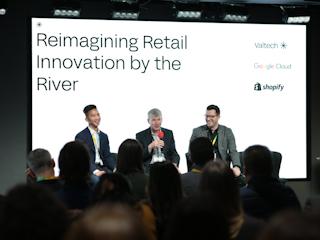2022-11-17
Intelligent recommendations strengthen your relationship with customers by personalizing their experience. But they rely on a solid foundation of data.
Do you know what your customers want, even before they do? Any organization that is able to anticipate its customers’ needs will secure a competitive edge. By making intelligent recommendations to customers about what they should do next, it can build an ongoing relationship based on trust and loyalty, unlocking value for both sides.
Many businesses understand the power of intelligent recommendations — they have been making them for years. When a customer walks into a department store, sales assistants will suggest items that are likely to be a good fit. When the owner of a vegan restaurant calls their wholesaler, they can expect to hear about the latest seasonal produce, not the best cuts of meat.
Today, digital channels offer businesses the opportunity to provide intelligent recommendations automatically and at scale. If they can master their data and create personalized profiles for individual customers, companies can use these recommendations to turn casual browsers into new customers — and new, anonymous customers into loyal advocates.
Personalized recommendations to drive value
The potential value of personalized recommendations may come as a shock to organizations yet to pursue such strategies. Amazon, an early pioneer of intelligent recommendations, has previously ascribed 35% of its sales to recommendations.
Despite this potential, many businesses are failing to explore the possibilities. A recent survey by technology analyst company Gartner found that 58% of consumers believe the digital experience offered by brands has little or no impact on what they end up buying; 49% can’t tell the difference between most brands’ digital experiences.
Market-leading organizations are working hard to remedy that. Netflix, for example, nets $1 billon a year in value from customer retention benefits earned through its intelligent recommendations.
The media giant makes suggestions to viewers about what to watch next based on a complex array of data points such as preferences and previous behavior. These recommendations are critical to building a relationship with the customer and, in turn, retaining them in a highly competitive marketplace.
Recommendations don’t need to be complex to be effective, however. US fashion retailer Forever 21 tailors search results on its website to what it knows about customers — it won’t respond to requests from male shoppers for “red shirts” with shirts designed for women, for example. This demonstrates how even a modest degree of intelligence can transform a customer’s experience.
Digital channels offer businesses the opportunity to provide intelligent recommendations automatically and at scale.
Don’t just recommend purchases
Crucially, not every recommendation has to suggest another purchase. The next best action for the customer could be to sign up for an event or regular updates from the company, for example, or to engage with another digital service. The aim isn’t always to sell, but to keep building the relationship and brand engagement.
“As much as I want the next step of our experience together to be a commercial transaction, what I’m really concerned about is the long-term retention of the customer,” says Brian Browning, who became Vice President of Technology, Products and Experience Service Line at Kin + Carta in March 2021. Valtech acquired Kin + Carta in 2024.
“I want to build the value of the customer over time, and recommendations are a key part of a larger personalization program that can drive that value.”
Many organizations are now trying different approaches. American Airlines’ app tells customers who own a Starbucks loyalty card where they can find the coffee outlet when they arrive at the airport, for instance. And when a member of the Million Dollar Round Table lands in a new destination, the trade association can suggest local meetings and networking opportunities.
“The more we can think about use cases beyond just the transactional, the stronger the relationships we will build,” adds Browning. “Each experience reminds the customer of the value of their relationship with the organization.”
Not every recommendation has to suggest another purchase.
Build the data
How, then, to make intelligent recommendations to customers interacting with the brand through digital channels? Above all, it requires data, specifically three broad types.
The first is data about the individual and their preferences. “Intelligent recommendations typically employ collaborative filtering and content filtering approaches,” explains Gary Arnold, who became Data Strategy Director at Kin + Carta in November 2021k.
“Collaborative filtering means looking at what people like your customer have done – what have they liked or bought, for example. Content filtering means looking at the content a person is interested in and recommending similar content.”
Both approaches require organizations to understand more about individual customers and build customer profiles. Can you identify a customer no matter which channel they choose to engage with the brand through? What do you know about similar customers? What can you infer, even if you don’t know, particularly about what customers think and feel?
The second kind of data needed for intelligent recommendations is operational. To be useful, recommendations must draw on information such as stock levels and availability. After all, there is no point recommending a product that is not in stock or that can’t be delivered.
“That’s another whole chunk of data that you should be trying to understand: for example, availability, pricing strategies, how you can get in front of them, and how you supply to the customer,” says Arnold.
A third crucial source of data is the outcome of previous recommendations. How did the customer respond to a particular recommendation — did they take it up or at least consider it, or was it rejected out of hand? Which recommendations worked well, and why?
This data can be fed back into the recommendations to optimize results, but this will take time, particularly for organizations with less mature data collection and management capabilities.
“The challenge is building detailed profiles of customers, centralising data rather than having it stuck in siloes,” warns Browning. “Once you have that, there are tools and methodologies to help you capitalise on the fact you know who your customers are and that you can segment them.”
The challenge is building detailed profiles of customers and centralizing data rather than having it stuck in siloes.
Learn and refine
More organizations are now recruiting specialists with the skills to build this sort of architecture, says Deepali Vyas, Global Head of the fintech, payments and crypto practice at executive search consultancy Korn Ferry.
“Everything has become so customer- centric; whether you’re delivering a product or a service or software, you need personalised distribution,” she says. “So, with that, we’re looking at a lot of predictive analytics, customer behaviour analytics and so on. The customer needs to feel like that business knows exactly what they want, how they’re going to go about delivering it and even predicting what they need.”
These are often industry-agnostic disciplines, Vyas points out, and organizations can learn from their peers in different sectors. “We recently helped a leading financial services firm hire a chief artificial intelligence (AI) and data analytics officer and they recruited from a technology company,” she says. “They wanted a fresh set of eyes on something they weren’t doing well enough.”
This is not to say that businesses seeking to capitalize on intelligent recommendations need to adopt the most advanced techniques from day one. Indeed, it makes sense to start with less demanding approaches. For example, rules-based recommendations make simple suggestions according to an agreed rule — if a customer bought new tires two years ago, for example, perhaps now is the moment to recommend a replacement.
This, in turn, can lead to more sophisticated techniques, such as harnessing AI to make smarter suggestions. Deep learning, for example, can be applied to large customer behavior datasets to identify opportunities for recommendations that might not be obvious to human experts, explains Lionel Touati, Google’s Head of Partner Engineering for EMEA South.
“It allows you to create much smaller segmentations,” he says, and therefore make fine-grained recommendations based on the precise behavioral characteristics of individual customers.
Furthermore, Touati says, AI-powered recommendations can be optimized for commercial KPIs, such as order value or the number of items purchased. This automates the feedback loop between the recommendations and their outcome. “You have this continuous improvement which makes the system much better,” says Touati.
That’s ultimately what you’re looking for: a differentiated experience that drives long-term loyalty.
Businesses can also be smart about how they collect data. They may opt to ask customers questions over time, for example, rather than overwhelming them with multiple requests in one go. Tapping into other data sources — in a responsible and compliant fashion — can also be rewarding; social media, for example, is a rich vein of behavioral and attitudinal data.
“Don’t be afraid to experiment,” concludes Browning. “Be creative rather than getting trapped in a formula — think about all the interesting ways that you can influence a customer journey and create a different kind of outcome. That’s ultimately what you’re looking for: a differentiated experience that drives long-term loyalty.
“Don't be afraid to experiment. Be creative rather than getting trapped in a formula.”
Upshot
-
Start simple — but get started. Customers expect online experiences to be personalized, and those that don't look dated. But a little intelligence can go a long way: If nothing else, define your high-value customers and find out what works for them.
-
Focus on where the issues are. Choose, say, three key areas where performance needs to improve — conversions and transactions are obvious places to start — and build hypotheses that can be tested in each one via experimentation. Once validated, build these hypotheses into the proposition.
-
Work toward a center of excellence. Build around personalization, with recommendations as a key component, expanding use cases and creating repeatable processes and technologies to address those use cases.












